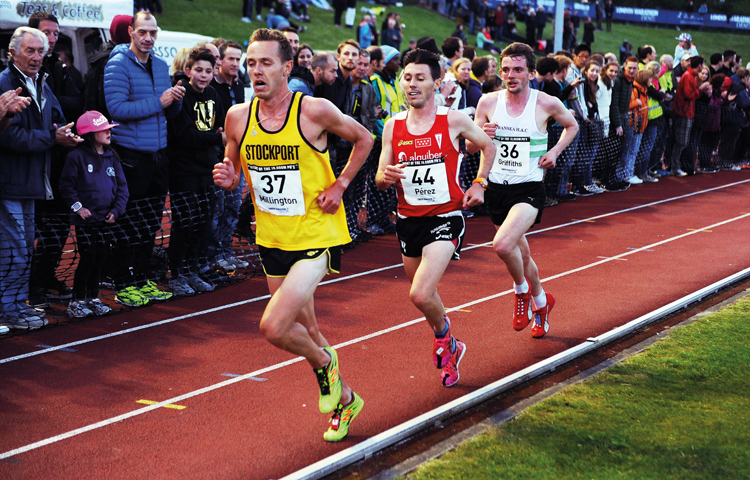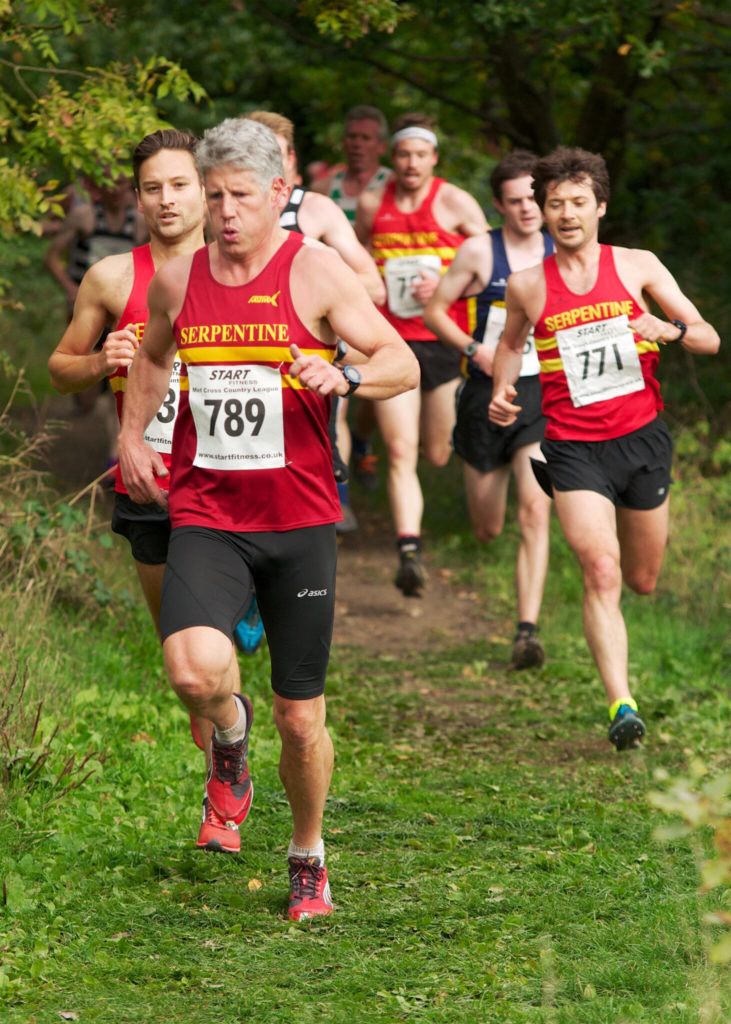
Stockport’s Ross Millington leads the 2016 Night of the 10,000m PBs
The heaving crowd was mad for it: shouting, cheering and revelling in a party atmosphere long into the chilly spring night. There was hot food and cold beer, accompanied by singers and dancers, acrobats and fire-breathers. Yet this wasn’t some random boozy festival this May – there were also athletes, and this was Parliament Hill athletics track.
This was The Night Of The 10,000m PBs (highgateharriers.org.uk), a guerilla athletics event organised by Highgate Harriers that has in just four years become the home of the national championships and trials for both the Olympics and World Championships.
And it could well be the saviour of one of running’s oldest and most traditional institutions: the athletics club.
A dying institution?
Running clubs are in trouble, we keep hearing. John Bicourt, who, as well as being an international coach, was the English 3,000m steeplechase record holder and a two-time Olympian in the 1970s, says, “Clear evidence from recorded participation across most sports and especially athletics is that numbers and standards of competitors, including the number of voluntary coaches and officials, across the board, are dropping not increasing.
“The vast majority of young people at 16 and over are clearly not interested in seriously taking up or continuing competitive sport. They’re simply not motivated enough. The London Olympics were sold to the nation – who paid for them – on the false premise of ‘increasing participation and inspiring our young and future generations to take up sport’, yet there was actually a drop in the level of competitive participation from before the Games.”
There are potentially many reasons for this. “Normal, everyday life has changed massively and this has had a huge effect on families, so I think a more flexible regime has become important,” says serial marathon runner Steve Edwards (750 and counting). On top of that, it’s clear that more people run to work, during their lunch hours or in the gym – things that didn’t really happen even a generation ago.
“Then I was talking to somebody recently who isn’t in a club but can train competitively on his own using Strava. Technology has given people that choice and some have welcomed it as it means they’re not tied to specific training nights or times.”
The decline is borne out by Bill Weeks, who was team manager of Belgrave Harriers for more than 30 years. “During that time we won the British Athletics League Premiership 11 times, represented British clubs in Europe 11 times and beat the Luch Moscow team – which comprised mainly their international squad – in a relay competition,” he says.
“When I gave up as team manager nobody would do the job so Belgrave withdrew its men’s team from British Athletics League. Now we have a joint men’s and women’s team in the Southern Athletics League Division 1. Track and field’s decline over the last 12 years has seen the demise of three cup competitions – there’s nothing now.”
Or is there? It could simply be the case that what athletics traditionalists expect from the sport is changing.
“The 10K was the ugly duckling of British athletics, even at a time when everyone was singing and dancing about Mo Farah,” says Ben Pochee, race director of The Night Of The 10,000m PBs.
“There were just no events in this country and athletes were going to Stanford in the States to try to post a qualifying time for the Olympics. You can probably afford it if you’re Mo, but it’s not so easy for everyone else. I saw an opportunity to create an open track meet, to build an event here every year and give it an atmosphere. It was about bringing that running club passion – that’s bubbling away below the surface – to the fore.”
The event itself is different to anything that’s gone before, with crowds in Lane 3 and a marquee along the back straight that houses a DJ and booze tent. “The runners go through the tent, which we call the Lactic Tunnel of Love. There are no IAAF regulations stopping people from coming on the track – it’s just tradition. We want to abide by the rules but change the traditions, and it’s worked. We had just 100 spectators in 2012. This year we had over 5,000.”
And while The Night Of The 10,000m PBs is a one-off, annual event, it’s indicative of a shift in how runners are using athletics clubs. “Highgate Harriers is an old and one-time traditional club. In the 1970s and 80s it was run by volunteers who had a narrow goal – to compete in events. For people new to the sport now, though, that isn’t as relevant,” says Pochee.
“There are so many different types of clubs now – Chorley in Manchester was set up for beginners and now it’s huge. There are women-only clubs, and gay and lesbian clubs. Serpentine in London is great, as they also cater for triathletes and kids, and they mix the training, competing, and social sides really well. Whenever I go to a race they bring the best cakes, and then lead a charge to the pub afterwards.”
“Aside from club trips to domestic and foreign races, my local club has organised things like treasure hunts,” says Edwards, while on another level completely there is GoodGym, a registered charity that combines running with volunteering in the community across London and several other towns and cities. And then, of course, there is a new sensation that doesn’t require its members to do any of that stuff, or pay to join: parkrun.

Members of Serpentine Running Club enjoy a training session around London’s Hyde Park
Free and easy
“The effect of local parkruns is probably greater than that of Team GB’s success at the Olympics,” says Ros Tabor, secretary of the Veterans Athletics Club. “We have a steady stream of new members from parkrun. We also get a big spike in membership when people get accepted into the London Marathon and want to train properly.”
But Laws disagrees on the former. “Parkrun has speeded up the demise of road running clubs, I think, by giving free competition to runners. Club runners have switched to parkruns,” he says.
“Plus, clubs used to hold their own open road races and got fees from non-members. That has now stopped.”
So how to attract new members? Firstly, it would clearly make sense to target the younger generation.
“The adult membership at my local club in the Cotswolds has been in decline for sometime now – it’s the lowest I’ve known since joining them in 2008,” says Edwards. “Conversely, the junior membership has been growing steadily and is very healthy.”
Secondly, it takes innovation to attract and retain newcomers. “What we see at our club is very talented juniors leave school, go to university and stop running,” he adds. “The gap in my mind is therefore people in their twenties and early thirties.”
And despite its excellent cakes, Serpentine has seen membership fall in recent years, from 2,400 in 2006 to 1,800 today. “The club started in 1982 and membership numbers grew relatively slowly but steadily, reaching 500 in 2001,” says Ian Hodge, Serpentine’s committee member responsible for athletics and cross-country. We’re still way above our 2001 membership level, but the decline is something we do see as a trend.”
Acceptable in the 80s
Clubs formed in the running boom of the eighties, like Serpentine, were focused on road running and attracted large numbers, with another boom in the early 2000s,” says Hodge. “I suspect those clubs that hadn’t – or haven’t – diversified into the likes of track and field, cross-country, and/or triathlon are seeing a decline in membership, as the more casual runners they attract don’t need clubs as much.
“My feeling is that we are not getting as many casual members as we were 10 years ago and those that do join are more serious and tend to renew their membership and stay with us. We’ve certainly seen a boom in participation in track and field and cross-country over the last few years.”
Yet the future certainly isn’t as gloomy as the traditionalists would have you believe, and there could be another reason for the slight decline in Serpentine’s membership – there are now 1,271 running clubs in the UK, compared to 1,072 in 2008, while membership has risen from 98,000 to 150,000 in the same time, so it’s clear that membership is spread over more clubs than it was even a few years ago.
What seems to have changed is what people want from their club, which perhaps explains why there are now more of them, catering for newcomers, casual runners and serious competitors. As Edwards says, “The more social type of club is probably more popular now than the training-based club.”
But whatever your goal, there will be a club to help you achieve it – and if there isn’t, you could always start your own.






